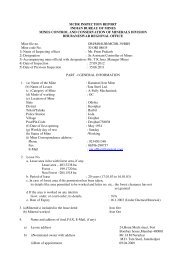Market Survey on Copper - Indian Bureau of Mines
Market Survey on Copper - Indian Bureau of Mines
Market Survey on Copper - Indian Bureau of Mines
Create successful ePaper yourself
Turn your PDF publications into a flip-book with our unique Google optimized e-Paper software.
d) Agitati<strong>on</strong> Leaching: It is rapid leaching <strong>of</strong> fine particles (usually 90% -<br />
75 micr<strong>on</strong>s) <strong>of</strong> oxide copper c<strong>on</strong>centrates/roaster calcines in str<strong>on</strong>g acid<br />
soluti<strong>on</strong>s. It requires <strong>on</strong>ly 2-5 hours leaching time.<br />
The leaching usually takes place c<strong>on</strong>tinuously in a series <strong>of</strong> 3-4 tanks<br />
with agitati<strong>on</strong> being provided by air or mechanical means. Rapid leaching is<br />
encouraged by high temperature (60 o C) operati<strong>on</strong>. Existing plant use co-current<br />
or counter current leaching. Counter current washing is also practiced to ensure<br />
that pregnant soluti<strong>on</strong> is entirely recovered from the leach residue. This process<br />
yields the highest metal recovery in shortest possible time but requires the<br />
highest capital investment.<br />
e) Bacterial Leaching: In certain cases, microbial leaching can be used<br />
for pr<strong>of</strong>itable copper recovery from low grade sulphide ore in heaps, dumps or<br />
in-situ in mines or deposits. The process is attractive because relatively little<br />
labour and capital investment are required compared with c<strong>on</strong>venti<strong>on</strong>al<br />
techniques and commercial leaching operati<strong>on</strong>s.<br />
f) <strong>Copper</strong> Recovery from Leach Soluti<strong>on</strong>: Pregnant soluti<strong>on</strong>s from<br />
leaching c<strong>on</strong>tain copper at sufficient c<strong>on</strong>centrati<strong>on</strong> for direct electro-winning <strong>of</strong><br />
high purity copper whereas soluti<strong>on</strong>s from in situ, dump and heavy leaching<br />
being weak, need additi<strong>on</strong>al treatment for copper extracti<strong>on</strong>. Cementati<strong>on</strong> and<br />
solvent extracti<strong>on</strong> are important for recovering copper from weak soluti<strong>on</strong>s.<br />
Both str<strong>on</strong>g and weak pregnant soluti<strong>on</strong>s c<strong>on</strong>tain impurities (ir<strong>on</strong>, cadmium,<br />
lead and zinc) inherited from the ore and they require purificati<strong>on</strong> prior to<br />
further treatment. This is achieved by precipitating ferric ir<strong>on</strong> from aerated<br />
soluti<strong>on</strong> with burnt lime at pH: 3-3.5 and by bleeding a porti<strong>on</strong> <strong>of</strong> electrolyte<br />
from the circuit for decopperising the discard.<br />
ii) Cementati<strong>on</strong>: As practiced in copper industry, the pregnant soluti<strong>on</strong><br />
flows through a pile <strong>of</strong> scrap steel and copper precipitates <strong>on</strong> the ir<strong>on</strong> surfaces<br />
as per the following reacti<strong>on</strong><br />
Fe + Cu 2+ � Cu + Fe 2+<br />
(Scrap) (Soluti<strong>on</strong>) (Cement <strong>Copper</strong>) (Soluti<strong>on</strong>)<br />
The copper precipitate detaches in flake or powder form under the<br />
influence <strong>of</strong> the soluti<strong>on</strong> flow. It is invariably c<strong>on</strong>taminated with ir<strong>on</strong> up<strong>on</strong><br />
which it precipitates (typical analysis: 85-90% Cu, 0.2-2% Fe, 0.5% SiO2 +<br />
Al2O3 and remainder oxygen). The cement copper is purified by melting in<br />
smelting furnaces/c<strong>on</strong>verters and therefore subjected to electro-refining.<br />
iii) Electro Winning<br />
Leaching operati<strong>on</strong> and leaching solvent extracti<strong>on</strong> produce soluti<strong>on</strong><br />
with dissolved copper. The copper from these soluti<strong>on</strong>s is recovered in the form<br />
<strong>of</strong> copper cathode by electrowinning. This process involves applicati<strong>on</strong> <strong>of</strong> an<br />
electrical potential between an inert anode (antim<strong>on</strong>ial lead) and a copper<br />
cathode both immersed in copper-bearing soluti<strong>on</strong>. The electrowinning cathode<br />
44
















